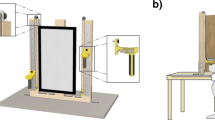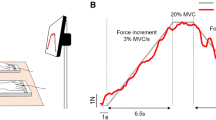Abstract
A number of studies have demonstrated high coordination of the hand grip force (GF; normal component of force acting at the digits-object contact area) and load force (LF; tangential component) in a variety of manipulation tasks. The aim of the study was to explore the mainly neglected effect of the change in LF direction and the effect of handedness on GF and LF coordination in bimanual manipulation task. Subjects (N = 14) exerted a bimanual sinusoidal LF pattern against externally fixed handles in trials that gradually changed from unidirectional (LF exerted only in one direction) to fully bidirectional (equal LF peaks in two opposite directions). Despite the gradual change of LF, unidirectional trials demonstrated high indices of force coordination, while in all bidirectional trials, no matter how low and brief LF exertion was in the opposite direction, all indices of GF and LF coordination deteriorated to a considerably lower level. The non-dominant hand demonstrated both a higher directional accuracy of exerting LF and higher GF modulation than the dominant one. We concluded that manipulation tasks performed in a single and two alternating directions may be based on partly distinctive neural control mechanisms, as well as that a switching of muscle synergies required in bidirectional tasks could play a role in the observed phenomenon. Regarding the effect of hand dominance, the recorded advantage of the non-dominant hand could be considered as an addition to the current views of the non-dominant arm/hemisphere specialization in controlling limb position.



Similar content being viewed by others
References
Augurelle AS, Penta M, White O, Thonnard JL (2003) The effects of a change in gravity on the dynamics of prehension. Exp Brain Res 148:533–540
Augurelle AS, Smith AM, Lejeune T, Thonnard JL (2003) Importance of cutaneous feedback in maintaining a secure grip during manipulation of hand-held objects. J Neurophysiol 89:665–671
Bagesteiro LB, Sainburg RL (2002) Handedness: dominant arm advantages in control of limb dynamics. J Neurophysiol 88:2408–2421
Bagesteiro LB, Sainburg RL (2003) Nondominant arm advantages in load compensation during rapid elbow joint movements. J Neurophysiol 90:1503–1513
Cole KJ, Abbs JH (1988) Grip force adjustments evoked by load force perturbations of a grasped object. J Neurophysiol 60:1513–1522
Domkin D, Laczko J, Jaric S, Johansson H, Latash ML (2002) Structure of joint variability in bimanual pointing tasks. Exp Brain Res 143:11–23
Duque J, Thonnard JL, Vandermeeren Y, Sebire G, Cosnard G, Olivier E (2003) Correlation between impaired dexterity and corticospinal tract dysgenesis in congenital hemiplegia. Brain 126:732–747
Fellows SJ, Noth J, Schwarz M (1998) Precision grip and Parkinson’s disease. Brain 121(Pt 9):1771–1784
Ferrand L, Jaric S (2006) Force coordination in static bimanual manipulation: effect of handedness. Motor Control 10:359–370
Flanagan JR, Wing AM (1993) Modulation of grip force with load force during point-to-point arm movements. Exp Brain Res 95:131–143
Flanagan JR, Wing AM (1995) The stability of precision grip forces during cyclic arm movements with a hand-held load. Exp Brain Res 105:455–464
Flanagan JR, Wing AM (1997) The role of internal models in motion planning and control: evidence from grip force adjustments during movements of hand-held loads. J Neurosci 17:1519–1528
Flanagan JR, Tresilian J, Wing AM (1993) Coupling of grip force and load force during arm movements with grasped objects. Neurosci Lett 152:53–56
Flanagan JR, Burstedt MK, Johansson RS (1999) Control of fingertip forces in multidigit manipulation. J Neurophysiol 81:1706–1717
Freitas PB Jr, Krishnan V, Jaric S (2007) Elaborate force coordination of precision grip could be generalized to bimanual grasping techniques. Neurosci Lett 412:179–184
Gysin P, Kaminski TR, Gordon AM (2003) Coordination of fingertip forces in object transport during locomotion. Exp Brain Res 149:371–379
Jaric S, Knight CA, Collins JJ, Marwaha R (2005a) Evaluation of a method for bimanual testing coordination of hand grip and load forces under isometric conditions. J Electromyogr Kinesiol 15:556–563
Jaric S, Russell EM, Collins JJ, Marwaha R (2005b) Coordination of hand grip and load forces in uni- and bidirectional static force production tasks. Neurosci Lett 381:51–56
Jaric S, Collins JJ, Marwaha R, Russell E (2006) Interlimb and within limb force coordination in static bimanual manipulation task. Exp Brain Res 168:88–97
Johansson RS (1998) Sensory input and control of grip. Novartis Found Symp 218:45–59; discussion 59–63
Johansson RS, Westling G (1984) Roles of glabrous skin receptors and sensorimotor memory in automatic control of precision grip when lifting rougher or more slippery objects. Exp Brain Res 56:550–564
Johansson RS, Westling G (1987) Signals in tactile afferents from the fingers eliciting adaptive motor responses during precision grip. Exp Brain Res 66:141–154
Johansson RS, Westling G (1987) Significance of cutaneous input for precise hand movements. Electroencephalogr Clin Neurophysiol Suppl 39:53–57
Johansson RS, Westling G (1988) Programmed and triggered actions to rapid load changes during precision grip. Exp Brain Res 71:72–86
Johansson RS, Riso R, Hager C, Backstrom L (1992) Somatosensory control of precision grip during unpredictable pulling loads. I. Changes in load force amplitude. Exp Brain Res 89:181–191
Krishnamoorthy V, Latash ML, Scholz JP, Zatsiorsky VM (2003) Muscle synergies during shifts of the center of pressure by standing persons. Exp Brain Res 152:281–292
Latash ML, Danion F, Scholz JF, Zatsiorsky VM, Schoner G (2003) Approaches to analysis of handwriting as a task of coordinating a redundant motor system. Hum Mov Sci 22:153–171
Li ZM, Latash ML, Zatsiorsky VM (1998) Force sharing among fingers as a model of the redundancy problem. Exp Brain Res 119:276–286
Marwaha R, Hall SJ, Knight CA, Jaric S (2006) Load and grip force coordination in static bimanual manipulation tasks in multiple sclerosis. Motor Control 10:160–177
Nowak DA, Hermsdorfer J, Glasauer S, Philipp J, Meyer L, Mai N (2001) The effects of digital anaesthesia on predictive grip force adjustments during vertical movements of a grasped object. Eur J Neurosci 14:756–762
Nowak DA, Glasauer S, Meyer L, Mait N, Hermsdorfer J (2002) The role of cutaneous feedback for anticipatory grip force adjustments during object movements and externally imposed variation of the direction of gravity. Somatosens Mot Res 19:49–60
Nowak DA, Hermsdorfer J, Marquardt C, Fuchs HH (2002) Grip and load force coupling during discrete vertical arm movements with a grasped object in cerebellar atrophy. Exp Brain Res 145:28–39
Nowak DA, Hermsdorfer J, Topka H (2003) Deficits of predictive grip force control during object manipulation in acute stroke. J Neurol 250:850–860
Ohki Y, Johansson RS (1999) Sensorimotor interactions between pairs of fingers in bimanual and unimanual manipulative tasks. Exp Brain Res 127:43–53
Oldfield RC (1971) The assessment and analysis of handedness: the Edinburgh inventory. Neuropsychologia 9:97–113
Paulignan Y, Dufosse M, Hugon M, Massion J (1989) Acquisition of co-ordination between posture and movement in a bimanual task. Exp Brain Res 77:337–348
Rost K, Nowak DA, Timmann D, Hermsdorfer J (2005) Preserved and impaired aspects of predictive grip force control in cerebellar patients. Clin Neurophysiol 116:1405–1414
Sainburg RL (2002) Evidence for a dynamic-dominance hypothesis of handedness. Exp Brain Res 142:241–258
Sainburg RL (2005) Handedness: differential specializations for control of trajectory and position. Exerc Sport Sci Rev 33:206–213
Serrien DJ, Wiesendanger M (1999) Grip-load force coordination in cerebellar patients. Exp Brain Res 128:76–80
Serrien DJ, Wiesendanger M (2001) Dissociation of grip/load-force coupling during a bimanual manipulative assignment. Exp Brain Res 136:417–420
Serrien DJ, Wiesendanger M (2001) Regulation of grasping forces during bimanual in-phase and anti-phase coordination. Neuropsychologia 39:1379–1384
Serrien DJ, Burgunder JM, Wiesendanger M (2002) Control of manipulative forces during unimanual and bimanual tasks in patients with Huntington’s disease. Exp Brain Res 143:328–334
Swinnen SP, Young DE, Walter CB, Serrien DJ (1991) Control of asymmetrical bimanual movements. Exp Brain Res 85:163–173
Westling G, Johansson RS (1984a) Factors influencing the force control during precision grip. Exp Brain Res 53:277–284
Westling G, Johansson RS (1984b) Factors influencing the force control during precision grip. Exp Brain Res 53:277–284
Westling G, Johansson RS (1987) Responses in glabrous skin mechanoreceptors during precision grip in humans. Exp Brain Res 66:128–140
Zatsiorsky VM, Gao F, Latash ML (2005) Motor control goes beyond physics: differential effects of gravity and inertia on finger forces during manipulation of hand-held objects. Exp Brain Res 162:300–308
Acknowledgments
The study was supported in part by grant HD-48481 from the National Institute of Health to S. Jaric. P. de Freitas has been partly supported by Fulbright Program (#15053184) and the Brazilian Government through the Coordination for the Training and Improvement of Higher Education Personnel (CAPES #2051-04/4)
Author information
Authors and Affiliations
Corresponding author
Rights and permissions
About this article
Cite this article
de Freitas, P.B., Krishnan, V. & Jaric, S. Force coordination in static manipulation tasks: effects of the change in direction and handedness. Exp Brain Res 183, 487–497 (2007). https://doi.org/10.1007/s00221-007-1064-3
Received:
Accepted:
Published:
Issue Date:
DOI: https://doi.org/10.1007/s00221-007-1064-3




